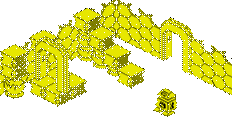Skate or Die! (1988) 
| Details (Commodore 64) | Supported platforms | Artwork and Media | |
|---|---|---|---|
| Publisher: Genre: Author(s): Musician(s): Minimum Memory Required: Maximum Players: Joysticks: Language: Media Code: Media Type: Country of Release: Comments: |  Electronic Arts Electronic ArtsBoard David Bunch, Stephen Landrum, Michael Kosaka, Nancy L. Fong Rob Hubbard, Kyle Granger 64K 1 Yes Eng N/A Audio cassette USA, Europe | Click to choose platform: Amstrad CPC Commodore 64 Sinclair ZX Spectrum Commodore Amiga Nintendo NES |
| Videos | Screenshots (Commodore 64) |
|---|---|
| (no videos on file) |
Please login to submit a screenshot
| Your Reviews |
|---|
 (Anonymous) (C64 Review) 19th Apr 2012 07:34
(Anonymous) (C64 Review) 19th Apr 2012 07:34Skating was very hip in the 80s for the youth. So the company Electronic Arts was full in line with the trend at the end of 1987 when releasing Skate or Die!. The game offers the possibility to compete in up to five disciplines either alone against three computer opponents (with different strengths) or against up to seven more human players. Before the start of the game, the game settings need to be selected in the skate shop. All players can enter their names via the "Sign-Up" function with the keyboard and then choose the colour of their board, except for black all colours of the C64 are available. With "Cancel" you end the sign-up. Then you skate out of the shop and choose if you want to play all disciplines or single disciplines (or practice if "Go Practice" is selected).
The audiovisual design at that time left only little to be desired and used the possibilities of the C64 very well. The title screen and music by Rob Hubbard caused some jaw-dropping right at the beginning. And unlike many other games with fancy title music and graphics, the quality of graphics and sound stay at a very high quality throughout the game, from the skate shop to the single disciplines. Unfortunately, all this high quality performance of every single discipline each of which has own animations and an own ingame music in two voices (one voice stayed reserved for the FX) resulted in extremely long loading and various disk flippings. So you have to suffer a little to enjoy all the many details such as detailedly animated and all in all very freaky sprites, soft scrolling at the downhill disciplines or also many saucy words.
Note for people interested in sound: The unique, sappy guitar samples in the title screen illustrate that the newer 8580 SID chips (without modifications/SID hack) are not capable of playing certain tunes - especially those including digis - designed for the 6581 series. Moreover, Electronic Arts - being a US company - created the game for the American market, which means for NTSC-Standard. Since an NTSC C64 is slightly faster clocked than a PAL system established in Europe, the Skate-or-Die! music runs noticably slower on PAL systems.
The audiovisual design at that time left only little to be desired and used the possibilities of the C64 very well. The title screen and music by Rob Hubbard caused some jaw-dropping right at the beginning. And unlike many other games with fancy title music and graphics, the quality of graphics and sound stay at a very high quality throughout the game, from the skate shop to the single disciplines. Unfortunately, all this high quality performance of every single discipline each of which has own animations and an own ingame music in two voices (one voice stayed reserved for the FX) resulted in extremely long loading and various disk flippings. So you have to suffer a little to enjoy all the many details such as detailedly animated and all in all very freaky sprites, soft scrolling at the downhill disciplines or also many saucy words.
Note for people interested in sound: The unique, sappy guitar samples in the title screen illustrate that the newer 8580 SID chips (without modifications/SID hack) are not capable of playing certain tunes - especially those including digis - designed for the 6581 series. Moreover, Electronic Arts - being a US company - created the game for the American market, which means for NTSC-Standard. Since an NTSC C64 is slightly faster clocked than a PAL system established in Europe, the Skate-or-Die! music runs noticably slower on PAL systems.
| Cheats | Trivia |
|---|---|
| There are no cheats on file for this title. | No trivia on file for this title. |
History
This title was first added on 11th April 2007
This title was most recently updated on 19th April 2012






